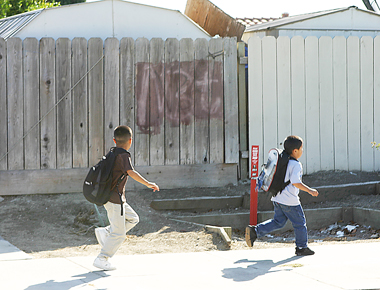Community rallies to stop gangs
There are as many as 1,000 gang members in San Benito County,
some of them as young as 10 years old. They come from almost every
part of Hollister.
Community rallies to stop gangs
There are as many as 1,000 gang members in San Benito County, some of them as young as 10 years old. They come from almost every part of Hollister.
The problem is only getting worse.
That’s the message some 250 people received Wednesday during an anti-gang forum held at the Veterans Memorial Building.
The issue of gangs is one that police and government officials have been struggling with for decades. There are no easy answers when it comes to stopping gang activity, but education starts at home. Parents can take an active involvement in their children’s lives and build their self-esteem so that the kids are not pushed toward a gang lifestyle.
Gangs typically form around ethnic and racial lines, in San Benito County gangs are predominantly Hispanic, but they don’t discriminate; if a kid wants to join and he’s not Hispanic, they’ll take it, said Nicholas Rabago, deputy probation officer.
Primary activities of gangs in San Benito County include drug sales, assaults, extortion, witness intimidation, money laundering and drive-by shootings.
Fr. Rudy Ruiz, a Catholic priest with Sacred Heart-St. Benedict’s Parish in Hollister, often has conversations with parents about gangs and he notices the same patterns. He said that a lot of the gang members are raised and baptized Catholic, so he gets to know their families. The kids who join gangs are often looking for an identity, they often have family problems, sometimes the parents are dysfunctional, or are victims of domestic violence, Ruiz said.
“The kids are lacking that familial acceptance in the home so they look for it elsewhere. They find a sense of identity through the gang affiliation,” Ruiz said.
A lot of the time poverty influences whether a kid joins a gang, Ruiz said. The kids are looking for power; they are looking for a sense of belonging. As early as the age of 5 kids start developing their self-identity, Ruiz said, so it is important to spend as much time with them as possible and develop their self-esteem.
The problem lies in the fact that sometimes parents are not aware of how vulnerable their kids are.
“Sometimes you have parents that were born and raised in Mexico and can’t really communicate with their kids,” Ruiz said. “The kids are like a pressure cooker. They’re suddenly included in the gang and they have an identity. That’s why it’s so important to grab them when they’re young and imprint on them how wrong it is.”
The church tries to instill the values of wrong and right within the family structure too. They are just as concerned with teaching young people how to be a person.
“That’s why before receiving the sacraments, we talk to parents about the importance of educating the kids. Sometimes parents send their kids to church and expect us to do all the work.”
A lot of the parents just don’t know. They can only offer their kids what they have, they lack an education or they’re fighting poverty, the kids become outsiders. The kids grow up and they aren’t proud of who they are,” Ruiz said. “That’s why I so admire the people who are former gang members who break away and try to educate the youth now about the dangers of gangs, that speak their lingo.”
There are also language barriers. When parents come from Mexico and their first language is Spanish, often they don’t learn English and depend on the children to let them know what’s going on.
San Benito High School counselor Jim Caffiero works with students who are at risk of joining gangs and he said that helps students who struggle with the decision of joining gangs.
“We talk about not making eye contact with the gang members and staying out of certain areas if they know members hang out there. We also talk about how to handle anger,” Caffiero said.
It is difficult because gangs appeal to the very nature of teenagers. They boost the ego and give young people a place to hang out with people who are similar, Caffiero said. Many of the people who look to gangs come from dysfunctional families.
“I think there is a relation between kids who are involved with gangs and parents who are disengaged. If parents know where their kids are 24-7 and supervise them there is not usually a problem,” Caffiero said. “The other problem is that many of the kids come from homes where it is a generational thing, dad was in a gang, so the son is in a gang.”
Rabago agreed. He said that some families in San Benito County have three or even four generations of gang members.
There is also a socioeconomic factor, in this depressed economy many families work 12-14 hours per day and cannot provide the family structure kids are looking for, they lack support so they turn to gangs, said Caffiero.
At a Wednesday night’s forum, non-profit groups from throughout the county came together in an effort to educate parents and make them more aware of the dangers that exist for their children so that they can help to curb the problem of gangs.
Lucy Arreola experienced firsthand the impact that gangs can have on a person as she watched her brother often come home beaten or on drugs. She didn’t want the same kinds of problems for her daughters, Ruby 12, and Jackie 10, so she took a proactive approach.
“I wanted my kids to learn about gangs from an early age. I’ve shown them that they can have love and support through family,” Arreola said. “I’m totally involved with what they do and I don’t leave them alone. I keep them on a really short leash. I wanted them to hear what these other people have to say about gangs so they can make informed decisions. Maybe they’ll be able to use the information later on.”
Maria Lozano is raising two children of her own in addition to her 15-year-old nephew. She’s worried that her nephew might succumb to the gang lifestyle.
“He’s at that age where it’s hard to keep tabs on him. We’ve talked a little about gangs, but nowadays so much is going on. They need to know that it’s serious; kids are getting killed every day. They think it’s cool, but they’re throwing away their entire lives, because innocent people are hurt by their actions. It’s all very scary,” Lozano said.
Parents learned how to identify behavioral traits that might indicate that a child is heading down a path toward a gang lifestyle. Indicators include low motivation; lowered education and occupational motivations; low self-esteem; behavior and discipline problems and drug use.
Police showed parents what gang tags look like so they could identify them if they find them amongst their children’s stuff.
Deputy Rich Brown of the San Benito County Sheriff’s Department works as the school resource officer for the county. He spends 80 percent of his time at the high school and said that problems with gangs don’t happen often. Occasionally he has to take away a gang-related article of clothing, such as a belt, but otherwise gangs don’t show much of a presence at the high school. He said that he high school guidebook lays out the educational codes and the consequences that come from violating the codes.
Anti-gang efforts face demise
Wednesday night families from throughout Hollister met with volunteers, officials and law enforcement officers to learn about the dangers of gangs and prevention methods for getting kids out of that lifestyle. Two hundred and fifty people were in attendance.
The gang task force is a combined effort between the police department, city officials, school representatives and members of the community all working together to try to put a dent in gang activity in San Benito County.
Police are limited in their capacity to deter gang activity, so the best weapon they have against the crime is informing the community and their voice box is the taskforce.
If Proposition R, a five-year, 1 percent sales tax initiative in the city of Hollister, fails to pass when it goes before the voters on Nov. 7, one of the first programs the city will cut is the gang task force.
The city has gone on record as saying that if it does not pass the sales tax initiative they will have to reduce city services including parks and recreation, streets, and some police service.
The cuts would not stop there. Likely other things will have to be cut in order to generate the approximately $2.7 million that is the current deficit. That amount will continue to decrease over the next several years, but all reserve funds will be exhausted well before the city reaches a balanced budget, said David Huboi, chairman of the “Yes on Measure R” committee.
Part of the reason the deficit exists is lack of development impact fees, but also because the state had had to dip into the coffers on more than one occasion, Huboi said.
The proposed sales tax adjustment will provide an additional $4 million revenue to keep the city solvent and sustain the vital services and programs that are important to the community, Huboi said. The adjustment will expire in five years. And part of the conditions of the approval of the increase would be a establishment of a citizens review committee which would annually review expenditure of the funds generated by Measure R and make a report to the council.
Patrick O’Donnell covers education for The Pinnacle. He can be reached at po*******@**********ws.com










